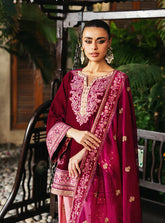Traditional Sindhi Bridal Dress in Pakistan
Traditional Sindhi Bridal Dress in Pakistan
The world of bridal fashion in Pakistan is a rich tapestry woven with cultural nuances and regional influences. Among the diverse array of bridal dresses, the Traditional Sindhi Bridal Dress stands out as a testament to the vibrant heritage and customs of the Sindhi community. This exploration delves into the intricacies and allure of the bridal dress in Pakistan, with a focus on the enchanting Traditional Sindhi Bridal Dress.
1. The Essence of Tradition: Embracing Sindhi Culture
The phrase "bridal dress in Pakistan" encompasses a myriad of styles, each rooted in the unique traditions of various regions. The Traditional Sindhi Bridal Dress, in particular, serves as a cultural ambassador, embodying the essence of Sindhi heritage. Adorned with intricate embroidery, vibrant colors, and symbolic motifs, this dress is a celebration of tradition that resonates with the soul of the Sindhi community.
2. A Kaleidoscope of Colors: Symbolism and Significance
The Traditional Sindhi Bridal Dress is a visual feast of colors, with each hue carrying its own symbolism and significance. Red, the predominant color, symbolizes joy, fertility, and prosperity. Green represents new beginnings and growth, while yellow is associated with happiness and optimism. The intricate use of colors in the dress reflects the depth of cultural meanings embedded in Sindhi wedding traditions.
3. Handcrafted Elegance: Embroidery and Embellishments
At the heart of the Traditional Sindhi Bridal Dress is the artistry of handcrafted embroidery. Skilled artisans meticulously embellish the fabric with traditional motifs, including ajrak patterns, mirror work, and intricate thread embroidery. This craftsmanship adds a layer of elegance and timelessness to the dress, making it a cherished piece that transcends generations.
4. The Ghagra and Choli Ensemble: Timeless Silhouettes
The Traditional Sindhi Bridal Dress typically consists of a ghagra (flared skirt) and choli (blouse). The ghagra, adorned with heavy embroidery and vibrant patterns, is a striking piece that exudes grace. The choli, complementing the ghagra, is often intricately designed and tailored to enhance the overall aesthetic. This ensemble, with its timeless silhouettes, captures the essence of traditional Sindhi attire.
5. Bridal Jewelry and Accessories: Completing the Ensemble
The Traditional Sindhi Bridal Dress is often paired with elaborate jewelry, including a matha patti (forehead ornament), jhoomar (side headpiece), rani haar (long necklace), and traditional bangles. These accessories add a regal touch, enhancing the bride's overall appearance and embracing the cultural significance of Sindhi bridal attire.
6. Bridal Veil and Odhni: Symbolic Drapery
The Traditional Sindhi Bridal Dress includes a veil or odhni, which holds cultural and symbolic significance. The veil is draped over the bride's head during various ceremonies, symbolizing modesty and purity. The intricate embroidery on the odhni adds an extra layer of beauty, turning it into a symbol of grace and tradition.
7. Celebrating Heritage: Sindhi Bridal Dress in Modern Times
While the Traditional Sindhi Bridal Dress is deeply rooted in tradition, its allure has transcended time and is embraced in modern times. Contemporary brides often blend traditional elements with modern aesthetics, creating a fusion that pays homage to the past while embracing the present. The evolution of the Sindhi bridal dress reflects the dynamic nature of Pakistani bridal fashion, where tradition and modernity coexist harmoniously.
Conclusion:
In the vast landscape of bridal dress in Pakistan, the Traditional Sindhi Bridal Dress stands as a testament to the richness of Sindhi culture and heritage. Adorned with vibrant colors, intricate embroidery, and cultural symbols, this dress is more than attire; it is a living expression of tradition and identity. As brides don the Traditional Sindhi Bridal Dress, they step into a symphony of culture and elegance, celebrating not just their union but also the timeless beauty of Sindhi traditions.





